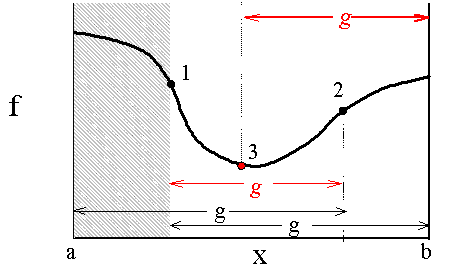
Golden Section Search

The Golden Section search method is one of two methods used in EES to find a minimum or maximum when there is one degree of freedom. The alternative method is the Recursive Quadratic Approximations method. The Golden Section method is illustrated in the figure above.
EES requires that you specify the possible range for the independent variable, X, before the search begins. This initial range is indicated by the values of a and b. Trial points are located at a fraction g from each end of the range. On each iteration, fraction (1-g) of the range is eliminated, as represented by the shaded area at the left of the graph. The process is then repeated with the reduced range. The trial points are again located at a fraction g from each end of the reduced range. However, to minimize trial points, one of the two trial points from the previous iteration is reused. This is point 2 in the figure.
The value of fraction g is dictated by the requirement that a point should be reused if it is not in a region that is eliminated. After eliminating the area to the left of point 1, point 2 remains. Point 2 was should now be situated so that it is fraction g from away from the new left bound.
At point 2: g (b-a) - (1-g) (b-a) = g [(1-g) (b-a)]
Solving, g = 0.61803 which is called the Golden Section.
Now point 3 is located at a position g away from the right bound and the process is repeated until one of the stopping criteria terminates the search.
Return to Min/Max